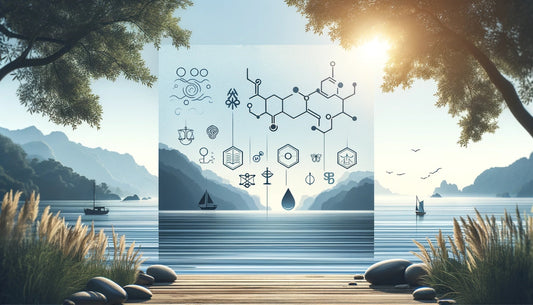What can you do to reduce COVID symptoms? What can be done to reduce long COVID symptoms?
Together with humanpeople’s scientific researcher, Daniel De Vries Robbe, I have looked into the recent research that has been put forward by doctors who are treating COVID patients. Recommendations are based on my own experience and also the world’s leading doctors in functional medicine on the treatment, prevention and amelioration of COVID-19 and its symptoms.
This is an overview of the current thinking (October 2021) for managing symptoms of COVID-19 if you do get COVID 19 or to reduce the length infection and long COVID symptoms. There are many lifestyle and dietary factors that are important, but this article focuses on the nutraceuticals, botanicals, minerals and vitamins that are emerging as helpful.
This is also personal for me because, despite being double vaccinated, I recently caught COVID-19 (October 2021). My wife and three boys (aged 7, 10 and 12) also all tested positive. Thankfully my illness was mild and the family are now well. I did, however, have 10 days of self-isolation to analyse all of the research about treating COVID 19.
COVID infection rates remain high (at the time of writing) and its after-effects are felt by many. Indeed a review study (published October 2021) on COVID 19 involving 7,639 people has revealed an overall prevalence of fatigue of 23%, defined as 21 days or greater post-symptom onset. (45)
Medical opinions we rate
Dr Mark Hyman and Dr Leo Galland have an in depth conversation on managing COVID symptoms, the full podcast can be found here.
The Institute of Functional Medicine has also added in depth material for a deeper dive including an in depth video from Dr Joel Evans, Dr Robert Rountree and Dr Patrick Hanaway.
Contents of this article
- Summary and overview
- What the latest science is saying
- So how do they work?
- My personal approach
- Loss of sense of smell (anosmia) and what may help
- An overview of the most recommended supplements for COVID-19
- The four not to ignore
- References
1. Summary and overview
The severity and effects of COVID-19 infection have a wide range of signs, symptoms, and variation in response both in the infective and recovery phase.
The coronavirus can be deadly because it is able to massively over-stimulate a part of the (innate) immune system, called the “inflammasome”. This cascade puts the body into a massive immune over-reaction.
Some botanicals and nutraceuticals (“BAN”s) are immune adjuvants and have been shown to make a significant impact on COVID-19 and the recovery from it. This means they affect the immune response either by accelerating, prolonging, or enhancing the body’s response.
Introduction
There are multiple approaches to improving health and recovery pre and post COVID-19. The scope of this article is to look at the evidence and science behind a number of BANs that have been in the press, and to separate hype from reality. We also examine some of the mechanisms by which they work. In other words how they:
1. Reduce the inflammation response.
2. Reduce viral replication.
3. Affect specific receptor interactions like ACE2.
To manage current infection or recovery it is essential to follow guidelines and seek medical attention when unwell. The information that follows presents current understanding of how we may be able to reduce the effects of the condition, but does NOT constitute medical advice or treatment.
All links to scientific papers to support any medical statements are in the reference section at the end of the article. These are numbered in brackets (23) beside the statement.
2. What the latest science is saying
Some evidence is supporting what we already suspected, but other evidence is more surprising.
Vitamin D (36) and omega 3 (44), which are well known for their anti-inflammatory and immune modulating properties, have been all over the general press – for good reason.
Maybe a little more surprising is vitamin A (10). More often linked to vision and healthy epithelium, there is strong evidence emerging for its immune-modulating properties.

Anti-inflammatory polyphenols:
BANs like quercetin (7) and curcumin (19) have well documented anti-viral and anti-inflammatory properties. The fact that evidence is increasing to show that they are effective is no big surprise.
The same is true for N-acetyl cysteine (“NAC”) (15), which increases glutathione levels and is strongly linked to reduced respiratory infections and the treatment of biofilm-related infection. This powerful nutraceutical has recently been made a prescription product in the US, but can still be bought over the counter in the UK. It has been shown to reduce the length and severity of non-COVID respiratory infections.
Resveratrol (30) is a well-researched potent antioxidant that Dr Leo Galland strongly favours due to its ability to influence ACE2.
Others with promising evidence:
The strength of evidence for zinc (1-3) is very strong and, in terms of evidence, is near the top of the pile. Given how common zinc deficiency is and that it is a readily available inexpensive mineral supplement, it is definitely worth adding to the list. The zinc/selenium combination is what we recommend as this also boosts an important glutathione enzyme (GPX-1 glutathione peroxidase).
Elderberry (29) (sambucus nigra) has long been touted for the treatment of viruses. It appears, however, that the science stacks up really well for COVID-19 and I’ve heard a lot of doctors recommend it, although I personally have not yet recommended it to patients. It’s one that we have been giving to our kids to help them get over infection because it is easy to take in the well known liquid form sambucol.
Outliers with promise:
Melatonin (21), and EGCG (41). EGCG, found in green tea. is a well-researched potent antioxidant. Some of the research, however, is conditional. This means that studies have not all been consistent in their results, so it is difficult to interpret.
The body of evidence for melatonin has mostly been associated with sleep rather than immune modulation. More research is needed.
Some practitioners have been using all of the above with good results anecdotally, but that doesn’t equate to clear evidence.
3. So how do they work?
Ok, now’s the time for a little bit of science. There are multiple different mechanisms to consider, but the two of most interest are those that reduce the inflammation response and those that stop the replication of the virus.
1. Activation of inflammasome = lots of inflammatory messengers (cytokines)
Unless you have been living under a rock you will know that the big issue with COVID-19 is that in some people the virus creates an enormous over-reaction from the body instead causing a moderate illness.
A cytokine is a chemical produced by the body to turn on the immune system and the level needs to be carefully tuned. During COVID-19 some of this tuning disappears and the volume of cytokines is turned up to 10.
The most important of these is “NLRP3 (3) inflammasome-mediated IL-beta” production. It is this pathway that is the target of treatments that regulate and reduce its production.
2. Reduction of viral replication
COVID-19 main protease (“M PRO”) is an enzyme that is required for viral replication. If it can be blocked this will reduce and inhibit viral growth. A number of treatments are aimed at this.
 How to reduce the risk of infection or to reduce symptoms?
How to reduce the risk of infection or to reduce symptoms?
Optimising health levels and reducing inflammatory markers is very important if you do get infected. Regardless of whether you are vaccinated or not there is still a high risk of infection, especially in the winter months and with the emergence of strains that are more infective. So if you are regularly interacting with others, have children at school, or are travelling on public transport, it may be a case of when you get infected rather if.
Regular movement, reduction of stress, and good food are more important than ever. If you want to reduce inflammation on the body, food is always first. Max out on antioxidants and fresh whole foods. Reduce the beige, fried empty calories and add colour into your food. Aim for five colours on a plate of real food – it tastes better and boosts health.
Recent infection: days 0-28
- The aim is to reduce chances of an inflammatory over-reaction of the “inflammosome” with anti-inflammatory behaviour, food and BANS
- Reduce viral replication (see list for those that help to reduce replication)
- Minimise symptom severity and duration
- Boost immune system
Immune balance: reduce the over-reaction of your system and increase antioxidants.
4. My personal experience with COVID-19
In October 2021 the first of my children got COVID-19 at school. The other two and then my wife followed. I finally tested positive two weeks later with some fairly minor symptoms such as a slight cough and bad aches for three days.
More annoyingly I also developed anosmia, the loss of my sense of smell. My anosmia lasted for around 10 days before slowly starting to improve. In the table below I have listed the nutraceuticals I was taking and those that I have added and will continue on for 8 weeks. I divide them into morning and evening.
I increased NAC and alpha lipoic acid to twice a day. The latter has some weak evidence that it may help with the recovery of sense of smell. My loss of smell recovered after 1 week but a study of 1 is not evidence!!
Supplements added for 8 weeks:
| New supplements | Dose |
|---|---|
| Zinc and selenium | 30mg zinc, 300mcg selenium |
| Resveratrol | 150mg twice a day |
| Quercetin | 600mg twice a day |
| Curcumin | 2500mg |
| Vitamin C | 1000mg twice a day |
Supplements I would have started if I was not already taking,:
| Supplement | Dose |
|---|---|
| Omega 3 (750mg DHA and EPA) | 1000mg |
| NAC (N-acetylcysteine) | 600mg twice a day |
| Vitamin D3 4000 IU and natural K2 | Maintain D3 at 100-150 nmolL |
| Multistrain probiotic | 20 billion CFU |
| Alpha lipoic acid | 600mg twice a day |
5. Anosmia is the loss of sense of smell. In COVID-19 this is due to damage to the olfactory nerve endings in the nose.
25% of people at 30 days after onset of COVID-19 have severe taste and smell issues. Most improve within a month, but over 7% still have an issue over two months later.
Here are three suggestions to help regain your sense of smell:
- 600mg of lipoic acid (“ALA”) may help. A 2002 ENT study showed that ALA has been used to treat peripheral neuropathy (damage to nerve endings). Remember that loss of sense of smell is damage to the olfactory nerve endings.
- Omega 3 1000mg
- Vitamin A 20,000 IU (not if pregnant) for 8 weeks
6. Overview of the most recommended supplements for COVID-19
| Nutraceutical/ botanical | What is it? | Effect on immune system | Ability to reduce viral replication | Strength of scientific evidence |
|---|---|---|---|---|
| Quercetin
Phytosome 600mg twice daily (7-9) |
Quercetin is a potent anti-inflammatory mediator that has been shown to inhibit viral replication and also reduce inflammatory messengers. | +++ | + | +++ |
| Alpha lipoic acid | Reduces inflammation to COVID and also slows viral replication, improves smell | ++ | ++ | +++ |
| Zinc citrate, acetate, picolinate
60mg (1-6) |
A common deficiency, it has a proven effect on the COVID response and viral replication | +++ | ++ | +++ |
| NAC (n-acetylcysteine)
600mg twice daily (13-15) |
Increases glutathione and has a synergistic effect with zinc. Potent immune support and reduces respiratory infection. | ++ | + | ++ |
| Melatonin
5-20mg at night (20-24) |
Helps sleep, reduces inflammation and appears to help gut health | + | + | + |
| Elderberry sambucus nigra 0.5-2g daily
(25-29) |
Packed with vitamin C, prebiotics and antioxidants. The evidence for treating viruses is surprisingly strong. Great for kids. | ++ | ++ | ++ |
| Resveratrol
100-150mg twice daily (30-32) |
Helps to reduce the inflammatory NLRP3 inflammasome, promising. | ++ | ++ | +++ |
| Vitamin D
4-10,000 IU depending on serum levels (32-36) |
Well researched for immune response with multiple proven mechanism (see appendix). | ++++ | ++ | ++++ |
| Vitamin A
10-20,000 IU (avoid in pregnancy) (10-12) |
An anti-inflammation vitamin important in mucus and epithelium strength. Critical immune vitamin. | ++ | ++ | ++ |
| Vitamin C
1-3g (37-40) |
Helpful in acute infection and in severe sepsis. Evidence is conditional | + | ++ | |
| Epigallocatechin gallate (EGCG)
200mg four times daily, 4 cups green tea a day (40-43) |
+ | + | + |
7. The four not to ignore
1. Zinc: There is strong clinical evidence that zinc supports the immune system. Deficiency is common and especially appears to be prevalent in populations with high risk of infection.
Zinc prevents viral infection and reduces its severity and duration. An inexpensive and safe intervention makes it a strong recommendation. (1-6)
| Intervention: | Zinc |
| Strength: | 30-60mg zinc citrate, acetate or picolinate |
| How does it work against COVID-19? | Modulates both the immune cells such as macrophages and affects the attachment and replication of viruses. |
| Outcomes: | Reduces severity of symptoms and reduces duration of illness. |
| Evidence level: | STRONG |
| Risk of harm: | Minimal |
2. Quercetin has long been used in health to reduce inflammation. It has potent effects against RNA and DNA viruses such as herpes. Also with antioxidant and anti-inflammatory properties the mechanisms of action are well understood. Use for 12 weeks is safe and effective. (7-9)
| Intervention: | Quercetin |
| Strength: | 1g twice a day for up to 12 weeks |
| How does it work against COVID-19? |
|
| Outcomes: | Reduces severity of symptoms. |
| Evidence level: | LIMITED. But use to reduce inflammation in general is STRONG. |
| Risk of harm: | Minimal with dose and duration |
3. Vitamin A is a potent anti-inflammation vitamin that we usually associate with vision, growth and development. In the medical world we know it has an important role in the epithelium and mucus health. It has strong immune regulation roles. We advise avoiding vitamin A in pregnancy, however, and not to exceed the recommended dose. (10-12)
| Intervention: | Vitamin A |
| Strength: | 10-20,000 IU per day |
| How does it work against COVID-19? | Modulate T cells and IgA antibodies. |
| Outcomes: | Reduces severity of symptoms and reduces duration of illness. Also reduces chances of death. |
| Evidence level: | STRONG |
| Risk of harm: | Minimal if correct dosage 12 weeks. |
4. NAC. We all know about glutathione and its importance to health. Avoid expensive glutathione liposomal preparations because the effectiveness is questionable.
NAC improves antioxidants, liver health and detoxification. (13-15)
| Intervention: | NAC |
| Strength: | 600mg twice a day |
| How does it work against COVID-19? | Cell defence and repletion of glutathione. |
| Outcomes: | Reduces illness severity. |
| Evidence level: | STRONG |
| Risk of harm: | Minimal |
And finally… mitochondrial support for headaches
Prolonged headaches are a common symptom of COVID infection and long COVID. MRIs taken from the UK Biobank of patients who have suffered from long COVID symptoms have shown brain changes to match symptoms of loss of smell and brain fog.
To boost mitochondria, NAC, alpha lipoic acid and zinc can all help. High dose CoQ10 (over 300mg) is also recommended if you have headache issues.
The aim of this article is to give a balanced overview of current thinking and evidence. We will post any significant updates, but in the meantime hope that it helps support you as well as your family, friends, and colleagues through this tricky time.
8. References
1) Fischer WC, Black RE. Zinc and the risk for infectious disease. Annu Rev Nutr. 2004;24:255-275. doi:10.1146/annurev.nutr.23.011702.073054
2) Fraker PJ, King LE, Laakko T, Vollmer TL. The dynamic link between the integrity of the immune system and zinc status. J Nutr. 2000;130(5S Suppl):1399S-1406S. doi:10.1093/jn/130.5.1399S
3) Shankar AH, Prasad AS. Zinc and immune function: the biological basis of altered resistance to infection. Am J Clin Nutr. 1998;68(2 Suppl):447S-463S. doi:10.1093/ajcn/68.2.447S
4) Acevedo-Murillo JA, García León ML, Firo-Reyes V, Santiago-Cordova JL, Gonzalez-Rodriguez AP, Wong-Chew RM. Zinc supplementation promotes a Th1 response and improves clinical symptoms in fewer hours in children with pneumonia younger than 5 years old. A randomized controlled clinical trial. Front Pediatr. 2019;7:431. doi:10.3389/fped.2019.00431
5) Finzi E. Treatment of SARS-CoV-2 with high dose oral zinc salts: a report on four patients. Int J Infect Dis.2020;99:307-309. doi:10.1016/j.ijid.2020.06.00
6) Rerksuppaphol S, Rerksuppaphol L. A randomized controlled trial of zinc supplementation in the treatment of acute respiratory tract infection in Thai children. Pediatr Rep. 2019;11(2):7954. doi:10.4081/pr.2019.7954
7) Dostal Z, Modriansky M. The effect of quercetin on microRNA expression: a critical review. Biomed Pap Med Fac Univ Palacky Olomouc Czech Repub. 2019;163(2):95-106. doi:10.5507/bp.2019.030
8) Therapeutic Research Center. Natural Medicines Database: Quercetin. https://naturalmedicines.therapeuticresearch.com/databases/food,-herbs-supplements/professional.aspx?productid=434#adverseEvents. Accessed September 21, 2020.
9) Wu W, Li R, Li X, et al. Quercetin as an antiviral agent inhibits influenza A virus (IAV) entry. Viruses. 2015;8(1):6. doi:10.3390/v8010006
10) Huang Z, Liu Y, Qi G, Brand D, Zheng SG. Role of vitamin A in the immune system. J Clin Med. 2018;7(9):258. doi:10.3390/jcm7090258
11) Cui D, Moldoveanu Z, Stephensen CB. High-level dietary vitamin A enhances T-helper type 2 cytokine production and secretory immunoglobulin A response to influenza A virus infection in BALB/c mice. J Nutr. 2000;130(5):1132-1139. doi:10.1093/jn/130.5.1132
12) Rodríguez A, Hamer DH, Rivera J, et al. Effects of moderate doses of vitamin A as an adjunct to the treatment of pneumonia in underweight and normal-weight children: a randomized, double-blind, placebo-controlled trial. Am J Clin Nutr. 2005;82(5):1090-1096. doi:10.1093/ajcn/82.5.1090
13) Clark RSB, Empey PE, Bay?r H, et al. Phase I randomized clinical trial of N-acetylcysteine in combination with an adjuvant probenecid for treatment of severe traumatic brain injury in children. PLoS One. 2017;12(7):e0180280. doi:10.1371/journal.pone.0180280
14) Bhatti J, Nascimento B, Akhtar U, et al. Systematic review of human and animal studies examining the efficacy and safety of N-acetylcysteine (NAC) and N-acetylcysteine amide (NACA) in traumatic brain injury: impact on neurofunctional outcome and biomarkers of oxidative stress and inflammation. Front Neurol. 2018;8:744. doi:10.3389/fneur.2017.00744
15) Sharafkhah M, Abdolrazaghnejad A, Zarinfar N, Mohammadbeigi A, Massoudifar A, Abaszadeh S. Safety and efficacy of N-acetyl-cysteine for prophylaxis of ventilator-associated pneumonia: a randomized, double blind, placebo-controlled clinical trial. Med Gas Res. 2018;8(1):19-23. doi:10.4103/2045-9912.229599
16) Gong Z, Zhao S, Zhou J, et al. Curcumin alleviates DSS-induced colitis via inhibiting NLRP3 inflammsome activation and IL-1? production. Mol Immunol. 2018;104:11-19. doi:10.1016/j.molimm.2018.09.004
17) Zhao J, Wang J, Zhou M, Li M, Li M, Tan H. Curcumin attenuates murine lupus via inhibiting NLRP3 inflammasome. Int Immunopharmacol. 2019;69:213-216. doi:10.1016/j.intimp.2019.01.046
18) Kunnumakkara AB, Bordoloi D, Padmavathi G, et al. Curcumin, the golden nutraceutical: multitargeting for multiple chronic diseases. Br J Pharmacol. 2017;174(11):1325-1348. doi:10.1111/bph.13621
19) Chainani-Wu N. Safety and anti-inflammatory activity of curcumin: a component of tumeric (Curcuma longa). J Altern Complement Med. 2003;9(1):161-168. doi:10.1089/107555303321223035
20) Ng QX, Koh SSH, Chan HW, Ho CYX. Clinical use of curcumin in depression: a meta-analysis. J Am Med Dir Assoc. 2017;18(6):503-508. doi:10.1016/j.jamda.2016.12.071
21) Harpsøe NG, Andersen LP, Gögenur I, Rosenberg J. Clinical pharmacokinetics of melatonin: a systematic review. Eur J Clin Pharmacol. 2015;71(8):901-909. doi:10.1007/s00228-015-1873-4
22) Wirtz PH, Spillmann M, Bärtschi C, Ehlert U, von Känel R. Oral melatonin reduces blood coagulation activity: a placebo-controlled study in healthy young men. J Pineal Res. 2008;44(2):127-133. doi:10.1111/j.1600-079X.2007.00499.x
23) McGlashan EM, Nandam LS, Vidafar P, Mansfield DR, Rajaratnam SMW, Cain SW. The SSRI citalopram increases the sensitivity of the human circadian system to light in an acute dose. Psychopharmacology (Berl). 2018;235(11):3201-3209. doi:10.1007/s00213-018-5019-0
24) Sánchez-López AL, Ortiz GG, Pacheco-Moises FP, et al. Efficacy of melatonin on serum pro-inflammatory cytokines and oxidative stress markers in relapsing remitting multiple sclerosis. Arch Med Res. 2018;49(6):391-398. doi:10.1016/j.arcmed.2018.12.004
25) Zakay-Rones Z, Thom E, Wollan T, Wadstein J. Randomized study of the efficacy and safety of oral elderberry extract in the treatment of influenza A and B virus infections. J Int Med Res. 2004;32(2):132-140. doi:10.1177/147323000403200205
26) Zakay-Rones Z, Varsano N, Zlotnik M, et al. Inhibition of several strains of influenza virus in vitro and reduction of symptoms by an elderberry extract (Sambucus nigra L.) during an outbreak of influenza B Panama. J Altern Complement Med. 1995;1(4):361-369. doi:10.1089/acm.1995.1.361
27) Tiralongo E, Wee SS, Lea RA. Elderberry supplementation reduces cold duration and symptoms in air-travellers: a randomized, double-blind placebo-controlled clinical trial. Nutrients. 2016;8(4):182. doi:10.3390/nu8040182
28) Elderberry for influenza. Med Lett Drugs Ther. 2019;61(1566):32. https://secure.medicalletter.org/w1566f.
29) Hawkins J, Baker C, Cherry L, Dunne E. Black elderberry (Sambucus nigra) supplementation effectively treats upper respiratory symptoms: a meta-analysis of randomized, controlled clinical trials. Complement Ther Med. 2019;42:361-365. doi:10.1016/j.ctim.2018.12.004
30) Berman AY, Motechin RA, Wiesenfeld MY, Holz MK. The therapeutic potential of resveratrol: a review of clinical trials. NPJ Precis Oncol. 2017;1:35. doi:10.1038/s41698-017-0038-6
31) McDermott MM, Leeuwenburgh C, Guralnik JM, et al. Effect of resveratrol on walking performance in older people with peripheral artery disease: the RESTORE randomized clinical trial. JAMA Cardiol. 2017;2(8):902-907. doi:10.1001/jamacardio.2017.0538
32) Anton SD, Embry C, Marsiske M, et al. Safety and metabolic outcomes of resveratrol supplementation in older adults: results of a twelve-week, placebo-controlled pilot study. Exp Gerontol. 2014;57:181-187. doi:10.1016/j.exger.2014.05.015
33) Rao Z, Chen X, Wu J, et al. Vitamin D receptor inhibits NLRP3 activation by impeding its BRCC3-mediated deubiquitination. Front Immunol. 2019;10:2783. doi:10.3389/fimmu.2019.02783
34) Hewison M. Vitamin D and immune function: an overview. Proc Nutr Soc. 2012;71(1):50-61. doi:10.1017/S0029665111001650
35 Fitch N, Becker AB, HayGlass KT. Vitamin D [1,25(OH)2D3] differentially regulates human innate cytokine responses to bacterial versus viral pattern recognition receptor stimuli. J Immunol. 2016;196(7):2965-2972. doi:10.4049/jimmunol.1500460
36) Zdrenghea MT, Makrinioti H, Bagacean C, Bush A, Johnston SL, Stanciu LA. Vitamin D modulation of innate immune responses to respiratory viral infections. Rev Med Virol. 2017;27(1). doi:10.1002/rmv.1909
37) Schloss J, Lauche R, Harnett J, et al. Efficacy and safety of vitamin C in the management of acute respiratory infection and disease: a rapid review. Adv Integr Med. 2020;7(4):187-191. doi:10.1016/j.aimed.2020.07.008
38) Zhang M, Jativa DF. Vitamin C supplementation in the critically ill: a systematic review and meta-analysis. SAGE Open Med. 2018;6:2050312118807615. doi:10.1177/2050312118807615
39) Vorilhon P, Arpajou B, Vaillant Roussel H, Merlin É, Pereira B, Cabaillot A. Efficacy of vitamin C for the prevention and treatment of upper respiratory tract infection. A meta-analysis in children. Eur J Clin Pharmacol. 2019;75(3):303-311. doi:10.1007/s00228-018-2601-7
40) Therapeutic Research Center. Natural Medicines Database: Vitamin C. https://naturalmedicines.therapeuticresearch.com/databases/food,-herbs-supplements/professional.aspx?productid=434#adverseEvents. Accessed September 21, 2020.
41) Lee HE, Yang G, Park YB, et al. Epigallocatechin-3-gallate prevents acute gout by suppressing NLRP3 inflammasome activation and mitochondrial DNA synthesis. Molecules. 2019;24(11):2138. doi:10.3390/molecules24112138
42) Furushima D, Nishimura T, Takuma N, et al. Prevention of acute upper respiratory infections by consumption of catechins in healthcare workers: a randomized, placebo-controlled trial. Nutrients. 2019;12(1):4. doi:10.3390/nu12010004
43) Mereles D, Hunstein W. Epigallocatechin-3-gallate (EGCG) for clinical trials: more pitfalls than promises? Int J Mol Sci. 2011;12(9):5592-5603. doi:10.3390/ijms12095592
44) Arnadottir H, Pawelzik Stimulating the resolution of inflammation through omega-3 polyunsaturated fatty acids in COVID-19 rational for the COVID-Omega-FTrial. Front. Physiol 2021 Jan https://doi.org/10.3389/fphys.2020.624657
45) Sandler C, Wyller V Long COVID and Post-infective Fatigue Syndrome: A Review Open Form Infect Dise 2021 Oct Published online 2021 Sep 9. doi: 10.1093/ofid/ofab440






